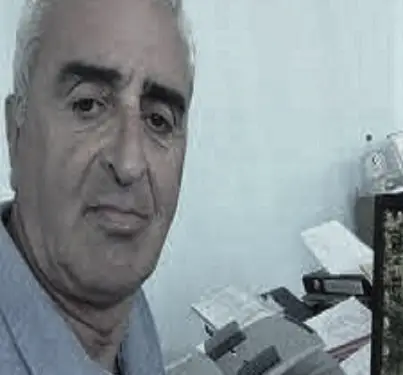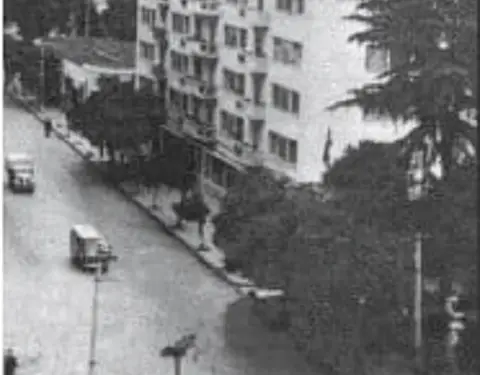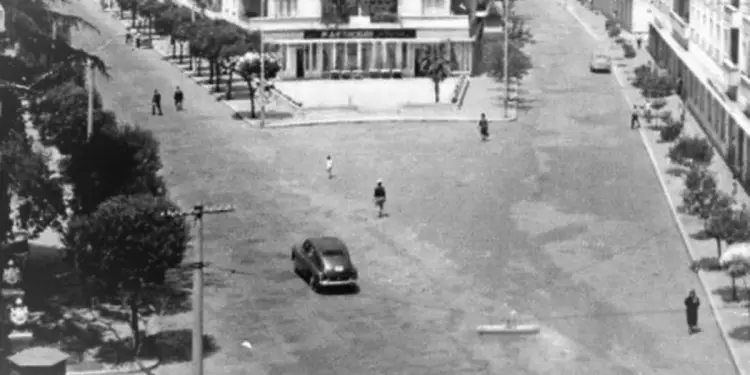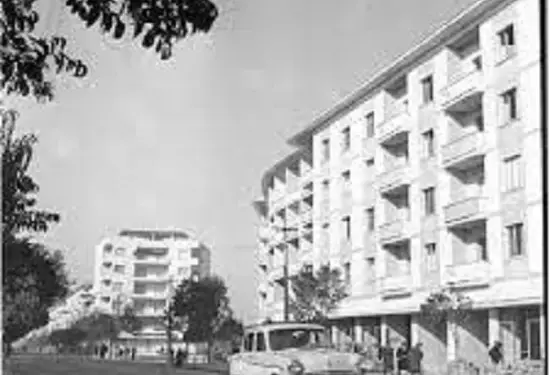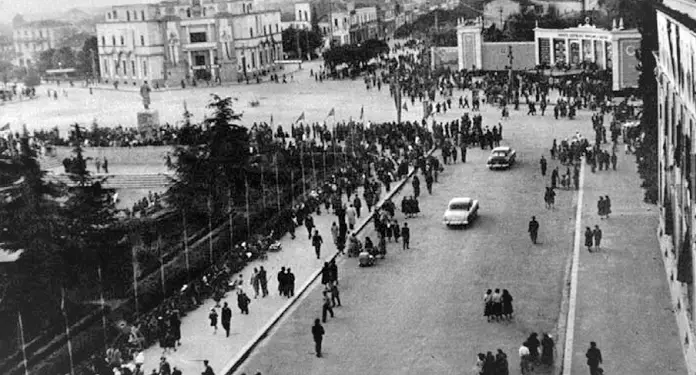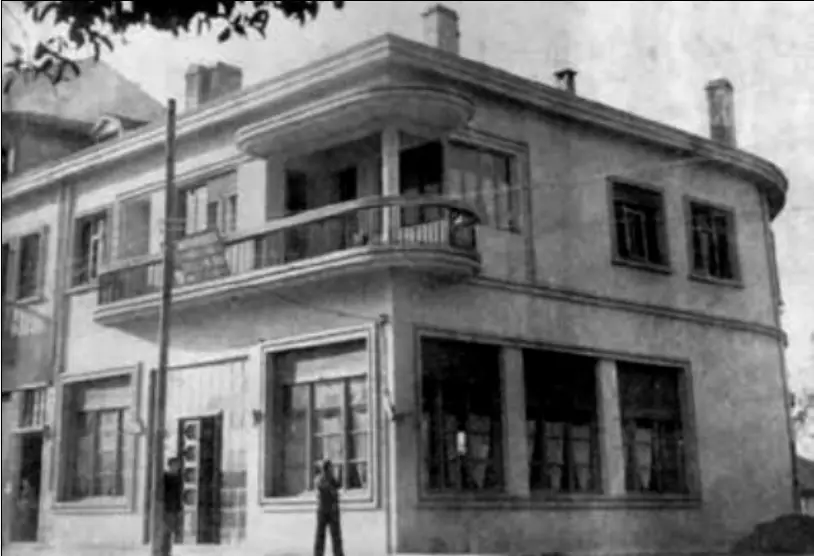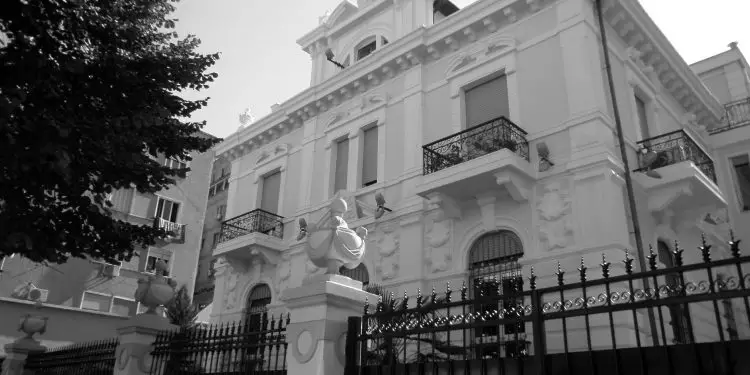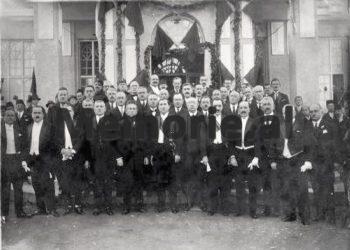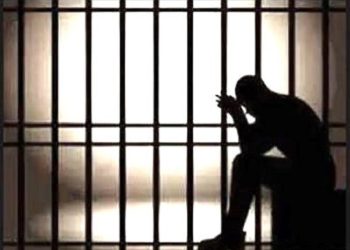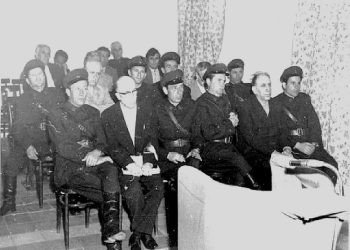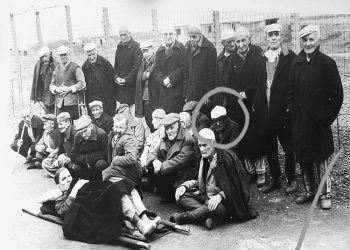From Uvil Zajmi
Memorie.al / “Rruga e Durrës”, designed at the time of Ahmet Zog, known as “Rruga e Durres”, then “Congresi i Përmet”, again “Rruga e Durres”, after the 90s, with three intersections in not even a kilometer, parallel to “Kavaja Street” and “Mine Peza”, initially the main road was the secondary segment that is today behind the Ministry of Education and that continues to the third intersection.
King Ahmet Zogu gave the idea to make a modern and functional central road for the time, with an east-west axis, and at the entrance to “Zogu i Zi”, where the Clock and the Mosque would be clearly visible as symbols of the capital. It would also serve his family to frequent the beach and his villa in Durrës. In its history, it carries many events, characters in particular after the 70s, when its attendance was great by the citizens of Tirana, including the “Black Bird”, the history of this area has been treated very carefully and interest in his book Prof. Y. Pango.
A street with many events, shops, legacies, institutions, or names, figures, soldiers, doctors, writers, actors, important characters of the Albanian society, who lived, or passed there, but above all with “Flora”, The modern dessert that gave life and great fame to that street, the loves, among them those of the Polish sisters who drove Tirana crazy and the boys of that street.
Ing. Prushi, the architect of the palaces
The construction of buildings on that street began at the end of the 50s, and in the first years of the next decade, some were completed and occupied, while in 1964, on the occasion of the 20th anniversary of Liberation, almost all the main frontal block was completed. Their architect was engineer Ibrahim Prushi, who gave great importance to the external appearance, buildings located on the only artery that connected Rinas airport with Tirana, where foreigners would pass, but also in road transport with the north-east of Albania, as the buses that left from the Travelers Agency behind the clock along the “Volga” (“Drin”) to Shkodër, Kukës, Pukë, Peshkopi, etc., passed there every day, until the railway station of Laçi started operating, Milot.
From Gastronomy to “Malev” Perfumery
Food or Gastronomy, this is how it has been known throughout the time it has been operating. A one-story multi-functional building on the left when the Street began, in the shape of a triangle, built right in front of the 5-story building that remains. It was not only a grocer but also a dairy, meat was sold, bread was sold, you could find everything there. While the Parfumeria was in front of the Gastronomy. With many names and fame for the time next to the first tunnel, it has even served as a reference point: We meet at “Parfumeria”. Very frequented, where the citizens of the capital bought ‘Cologne’ as it was called in bottles or even open.
This Perfumery has been a symbol of that road. A large patisserie that came after the Perfumery, to continue with the Gjellatore and the Hungarian “Malev” Air Agency. Very close to the second tunnel, this travel agency was the only one that connected Albanians with the world, and whoever entered there was understood to get a plane ticket and go abroad. From Feliks Baçi, to Elisabeta, Moza, Arjan Kotoni, Soveti, to Kujtimi, the driver of the agency was the man they had and was a friend of all the visitors of the area.
Knitting and acrylic turtlenecks
He was like that, more than famous and with a big name for the time. Known for the production of his golfs, “Trikotazhi” a large workshop on the right side and the first floor of the building at the entrance of the secondary road on the side of Flora, which deviates from the central one named “Mine Peza”. The flow, the queue for a custom golf sweater, was extraordinary, since the use of golf, was the fashion of the time, you can even order a golf sweater, with or without removal.
With 300 gr. acrylic wool that you could buy there or find elsewhere, take the measurements and golf shirts, sweaters for men and women, boys and girls. For many years, that workshop has been operating, which got its name from the very frequent golf courses for the youth of those years, which were fashionable. Having a friendly knitwear worker was a big favor. Fake golfs were also applied.
The salameria of Gazhels
Very popular and frequented was this store, the last one down in the first building on the left, next to the wall of the Cuban embassy. Not only for what was traded there, but for the friendships Gazhelt had with athletes and artists. Fat Gazheli, a well-known and popular cyclist, mainly gathered the “Partizani” volleyball players, such as: Dash Fagu, Ylli Tomorri, Bert Borova, etc.
Even before important meetings, such as with “Dinamo”, during the great rivalry of the time, coach Kona was calm when he saw his players there, as he treated the attitude of them together. Then a long rare one for salami, mainly the 140 lek one, or the “Tourist” one, where along with Xhavit Gazheli was also the other seller, Jaho Pronja.
At midnight for a “Mifa” and “Robusta” bicycle
It is about the last store in the row of those on the first floor of the long building that connects the Cuban embassy with the Court of Tirana. Very well-known as bicycles, motorcycles, motorbikes, then televisions and refrigerators have been sold there over the years, and then as a ‘Service Repair’ shop for televisions.
To buy the bicycles of the brand “Mifa” and “Robusta” men and women, after being informed, people rarely called after midnight and with lists in hand, they waited for it to open to buy one, since they were very busy for the time. Then also the Chinese ones. “Java” engine – 250 cc, which cost 54,000 ALL, was also sold there. Then URT TVs and “Obodin” or “Ingnis” refrigerators, 45,000 ALL.
Famous legacies
This is how they are called, Legates, in everyday language, although they are officially known as embassies. The Yugoslav legation, the Polish, Soviet and Cuban legations, three of them located on the edge of the road, of which only the Polish legation has been a little more involved. For many years, the Soviet embassy, also known for the horrifying story of the “bomb” that unjustly punished many innocent people with death and imprisonment, was the building where the Ministry of Education is today, and at least until the day diplomatic relations was broken.
While the Yugoslav one, (former War Museum), with three very beautiful small villas, almost at the third intersection, especially during the 1970s and 1980s, was under full surveillance, especially when from a window an apartment located on the first floor in the opposite building, State Security employees worked in three shifts.
The situation was so tense that at the booth located in the outer perimeter, when someone stopped to look at the photos, the police came out of the booth and said in a low voice: “Citizen, leave, don’t stay there.” Then came the Polish woman inserted a few meters into one of the streets of the second intersection, (she was also guarded by the window of an apartment opposite), to continue with the Cuban embassy, a well-maintained two-story building at the beginning of “Durres Street” , that apart from a policeman, there was not much care for him.
Even the Court in that way
Two were the main departments, but very important in this way: the Ministry of Education and the Court of the City of Tirana. It was built and after it functioned for several years as the Soviet embassy, but after the demolition, it served as the Ministry of Education, until today it has that function.
Once in its surroundings, for many years there was also the Albanian Football Federation, the Editorial Office of the newspaper “Sporti Shqiptar”. While the other important institution was the Court, a three-story building in which famous court proceedings were held for many years.
Being on a main street and almost in the center, it was frequented by students, students who dropped out of school to attend sessions, but also by many Tirana citizens who spent the morning there. The convicts were brought in a “prison-car”, and at one of the eastern side entrances, the prisoners got off accompanied by policemen who escorted them to the halls where the process took place. Entry was free except in specific cases. When it came to famous people, the flow in the court premises was very great, as friends or relatives waited for the person to enter and then to leave, as the trials and dates were published on a board.
From Vasil Laçi, to Khrushchev, Sihanouk and Chu En Lai, Cruyff and Beckenbauer
It was and remains the only road connecting Rinas airport with Tirana, and as such every delegation, personality, teams, sports clubs passed there, everyone who landed at Rinas to come to Tirana, had to cross that segment. In particular, the friendship delegations, when all the work centers were organized and came out for their reception along the road, pupils and students, officials and with flags and flowers in hand greeted the newcomers.
From Victor Emmanuel, Khrushchev, the King of Cambodia, Norodom Sihanouk, Chu En Lai to Baker, Pope John Paul, but also George Best’s Ireland, Beckenbauer’s Germany, Overat, Netzer and Muller, to Ajkas with Cruyff, Oransoda with two Americans , an infinity, athletes, artists, everyone has passed there.
Vasil Laçi even committed the assassination of the King of Italy, Victor Emanuel the Third, during his visit to Albania. What is remembered about this road is the placement of buses in a horizontal shape at the Cuban embassy for the traditional holidays of May 1 or the military parades of November 28 and 29, in order not to allow the passage of uninvited persons to these events.
Palace of Officers, for artists and sportsmen
Built at the third intersection of the Durrës road, in the shape of an arch on the left when you come to Tirana, it is known by everyone even today as the Palace of Officers, but this name had nothing to do with those who lived there , as it was and remains the ‘Palace of Artists and Sportsmen’.
Even the “Partizani” Club was once adjacent to it. Well-known writers, composers, artists and athletes have lived and grown up in that six-story building. From Nonda Bulka, Pavlina Nika, Mentor Xhemali, Feim Ibrahimi, Anita Take, Kujtim Laro, Xhevdet Hafizi, sisters Irma and Eranda Libohova, or Besim Fagu’s family (Agim Fagu spent his youth in that palace), to footballers: Robert Jashari, Mikel Janku and Loro Boriçi.
Drago Siliqi, a writer’s drama
Very charming, newly married and living on “Durres Street”, in the first building above Parfumeri, the life of the writer Drago Siliqi, would unfortunately be very short. Poet and publicist, after completing his higher studies at the University of Moscow, he worked as the director of the “Naim Frashëri” Publishing House in Tirana.
He died on July 13, 1963, at the age of 33, in an air accident when the Aeroflot Tupolev Tu-104 B plane, flying from China to Albania, crashed in the Siberian Mountains, near the city of Irkutsk in the Soviet Union. . In this accident, 32 people died, including six Albanians, among them Drago Siliqi and the ambassador’s wife Reiz Malele, with their two children. Drago Siliqi left his wife and two daughters, Darina and Laura, who have spoken on “Voice of America” for years.
Doctor Mokini with his “Jack”.
Doctor Potrucian Mokini, was a well-known doctor, with an Armenian background, Ahmet Zog’s doctor, but he stayed in Albania, and did not leave with King Zog. His son, Vasken Mokini, for many years a doctor at the Military Hospital, when he returned to Albania in 1943, after having completed his medical studies in Austria, brought a monkey by ferry from Italy, which was bought by a German soldier. With the name “Jack, the monkey, very special, with a white band on his head, during the day he stood at the window, wearing a blouse like a sweater.
For more than 15 years that he lived, he became a charismatic character and loved mainly by the citizens of the capital who deliberately passed that way to see the monkey “Jack”, even when they wanted to insult someone, they used the expression: “You have become like Dr. Mokin’s monkey.” Sotiri, the man of religion, resident of that street, the first man who represented the Orthodox religion in Tirana. Known by all the residents of Durrës Street, he lived in a palace apartment at the second intersection.
Tall, very charming, graduated in Economics, he served for many years as a priest in the Orthodox Church on “Kavaja Street”, until 1967, the day when religion was no longer allowed. Then there were problems, like all clerics, they even tried to convict him, imprisoned him, but he turned out to be innocent and for many years that followed, he worked as an economist in an enterprise in the capital.
The Polish sisters, who drove Tirana crazy
The story of the Polish sisters, who gained fame and became a phenomenon as the protagonists of this street, is related to the mid-1960s-’70s. Zasha and Grisha, were the daughters of an official of the Polish embassy, who systematically came for vacations during the summer period in the capital.
They lived in the first entrance on the second floor of the building in front of the Ministry of Environment, (or “Bar Roberti” today), an apartment that was successively inherited by various embassies personnel. Very beautiful blondes, with long hair and bangs, 22 and 19 years old, a provocative situation was created around them with many charming boys from Tirana, even to the point of love affairs and small flirtations between them.
Zasha’s love made more of a fuss, with a black bodyguard from the Cuban embassy, tall, dressed in a white suit, a very handsome boy with curly hair, who attracted attention when the couple sat at “Flora”. They were the ones who brought the first miniskirts with sides, very provocative, for the boys who stood on the curbs, waiting to see them as they passed. Many of them even started learning English to communicate with them.
They were admirers of music, in particular of the American singer Tom Jones. It was enough to play the melody of the song “Delilah” for them to run out on the balcony, even though they were guarded by State Security employees, they did not hesitate to endlessly provoke the passions and sympathies of the boys of that street towards them. Even with the most spectacular love stories, which are still remembered today by the residents of the palace where they lived (“Demneri”), unique for the time.
Even today, that dairy shop is remembered and bears the mythical name “Demneri”. Very common as a store, what made it special was that it was famous and favorite on that main street behind “Flora”, the man who gave it its name, the salesman Zyhdi Demneri, a noble model who served there.
He may have been the only seller or merchant, not only polite, polite, silent and tireless, but surprisingly the customer addressed him with the expression: “What do you order Madam, as God orders, thank you Madam, etc.”, reflection of an unusual upbringing, words that did not sound good and were not used for the time. Unforgettable, a more than authentic person for that road, for that generation.
The workshop, “Custom shoes”
Another workshop, which got a name and had a great influx for as long as it operated on that street, was that “Custom shoes with reverse”. Located at the second intersection (then it was moved next to Trikotazh), the store of this format gave Albanians the opportunity to order shoes, but on one condition, by handing over the backs of another pair of shoes, now out of use.
After placing your foot on a piece of paper, an employee would take the measurement with a pencil and decide on the shoe model. They cost 750 ALL, and such models were widely spread, not only in Tirana, but throughout Albania. All you have to do is find a pair of bad shoes to warrant a new pair of shoes. To cope with the demands, it worked in three shifts and that company had accumulated the best specialists that were in circulation. A pair of shoes with a seam on top, according to Italian models, was a preference for men of the time.
“Hotel Pensioni”, how nostalgic!
While the beginning of the road would be the one with the Food or Gastronomy, at the end of it, at the triangle that is still there today, there was a hotel, almost legendary for the time, named “Hotel Pensioni”. Located in the arch of the palace, it got this name because families lived and sheltered there for a long time. It was one of the few hotels that operated in this way, temporarily providing homeless families, or those transferred to Tirana, with temporary accommodation with rooms that had been turned into apartments. At that hotel, there were no daily bookings, but it operated as such, with permanent residents and families, until they found apartments to move to. Memorie.al




